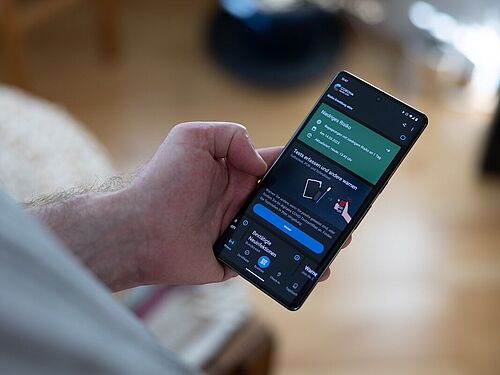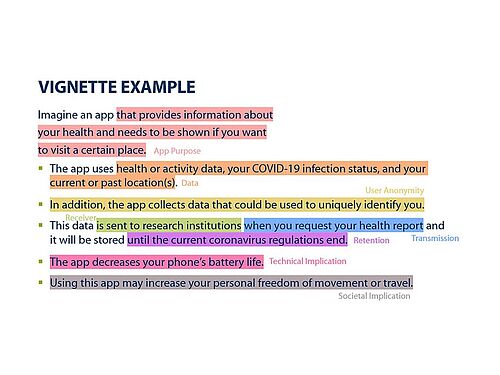Following the outbreak of the Sars-Cov-2 virus, many countries around the world introduced smartphone apps in an attempt to control the pandemic more effectively by enabling contact tracing and breaking infection chains as quickly as possible. The German government, too, urged citizens to install the so-called Corona-Warn-App, which would notify them if they recently had close contact with a person infected with the virus. How effective such apps are depends to a large extent on how widely they are accepted and, ultimately, how many people use them. What motivates people to use Covid-19 apps? And what puts them off? A research team of the Horst Goertz Institute for IT Security at Ruhr University Bochum led by Professor Markus Dürmuth and Dr. Christine Utz surveyed around 7,000 people on three continents to get to the bottom of these questions.
Innovative vignette design
In order to figure out which factors influence people’s decision to install an app or not, Utz and Dürmuth used a study design based on a technique extensively used in human-computer interaction and market research, the so-called vignette design. Market research in particular makes extensive use of this method. “Vignettes are short, fictitious scenarios that are presented to the survey participants who then have to answer questions about these scenarios. In our case, the questions are about fictitious Covid-19 apps with a range of different features that are based on real apps,” explains Utz. “When it comes to Covid-19 apps, the context in which they are used is crucial,” points out Dürmuth. “Which purpose does the app serve? What kind of data is collected and how long is it stored? Who can access the data? Our aim was to take all these dimensions and factors into account,” says the IT expert.
In their studies, the researchers explored a total of eight app functionalities – such as the purpose of the app and the duration of data storage – with up to 16 different selection options. This combination resulted in around 50,600 different scenarios. One of them was, for example: “Imagine an app that is used for quarantine control and shares your location with the public health department and the local police once per hour.” Every participant was presented with ten such scenarios and asked to rate how likely they would be to use each presented app. “The advantage of this design is that it ultimately enables us to calculate from the data how various factors influence overall acceptance and to precisely describe which factors influence user acceptance to a great extent and which do not,” outlines Dürmuth.
Surveys in China, USA and Germany
For the initial surveys in summer 2020, the researchers addressed 1,000 participants from China, the USA and Germany each. “In China, where the pandemic first broke out, people are more accustomed to government-issued apps, which is why this country was of interest for us,” explains Dürmuth. Germany was also an obvious choice as a destination for the study. “In terms of privacy expectations, Germany represents the European attitude during this period,” Dürmuth continues. “The USA were massively hit by the virus at the time of our first study. We expected that people in the USA would view the use of the apps in a different light and consider, for example, the protection of their privacy less important,” Utz explains the choice.
Availability of apps
At the time the survey was launched, the pandemic had reached different stages in different countries – and so had the use and deployment of Covid-19 apps. “In China, the widely used WeChat and Alipay apps had already issued health plug-ins. About 60 per cent of Chinese respondents said they were using them,” points out Utz. The situation was different in Germany and the USA at that point, with no apps or only a few apps available on the market. “In the summer of 2020, in the USA, about seven per cent of participants resorted to healthcare apps; in Germany, about four per cent used NINA, the warning app issued by the Federal Office of Civil Protection and Disaster Assistance,” says Dürmuth.
This changed over the course of a year, as revealed by follow-up surveys in winter 2020 and spring 2021 conducted with participants from Germany and the USA. In early 2021, 43 per cent of all respondents in Germany were already using an app, most of them the Corona-Warn-App. The numbers also increased in the USA; however, the overall usage rate remained comparatively low over the three survey rounds. “In spring 2021, only eleven per cent of Americans said they used an app. One possible explanation is that there was no unified app solution for all states,” hypothesises Utz.
Pandemic progression a decisive factor
The researchers attribute the notable increase in app use in Germany primarily to the nationwide availability of the new Covid-19 warning app and its widespread use. As Dürmuth puts it, “People who are familiar with the app are more willing to use it.” Moreover, the survey data shows that despite all initial scepticism, people generally seemed to be willing to use apps to help fight the pandemic. “The positive aspects and the overall benefits outweigh the scepticism,” says Utz. In fact, as evidenced by the survey results in Germany and the US, Covid-19 apps were perceived more and more favourably as time went on. In the third round of the survey in spring 2021, 294 out of 1,000 Germans and 302 out of 1,000 US Americans reported that they did not see any negative aspects about the apps. Utz and Dürmuth also attribute this result to the pandemic situation during the survey periods. “The second survey in particular coincided with a period of high infection rates and lockdowns,” Utz sums up the context.
Privacy remains a crucial factor
And yet: regardless of the availability of apps and the pandemic situation, it became apparent over the entire survey period that, on all continents, people’s willingness to use Covid-19 apps depends heavily on how well their private data is protected. “The question of what happens to my private identity-related data affects my willingness to use the app to a large extent,” stresses Dürmuth. Back in the summer of 2020, 292 out of 1,000 Germans cited concerns about data privacy as the main reason why they did not use Covid-19 apps. In the USA, this applied to 337 of the 1,000 respondents, and in China to 179. These reservations persisted throughout the three rounds of the survey: in the third round, 226 of 1,000 respondents from Germany and 257 of 1,000 respondents from the USA still regarded the apps as invading their privacy, which was one of the main reasons for not using them. Moreover, people feared surveillance by the state - this concern was expressed by 174 participants in Germany and 70 in the USA in the first round of the survey.
Crucial concern: who receives the data?
In all countries, the question which institution receives the data plays a crucial role in people’s decision for or against an app. “Our survey showed that there is a high level of trust in public health institutions – in Germany, for example, this includes the Robert Koch Institute (RKI) and universities. People tend to make their data more readily available to these trusted institutions. But this is fundamentally different if the recipient is a private company, the general public or law enforcement, depending on the country,” says Utz. In Germany, the prospect of private data being passed on to certain recipients such as the police or private companies reduces people’s willingness to use Covid-19 apps to a considerable degree. In China, people are more willing to share their movement data with the public. People are sceptical only with regard to private companies. “Here, sharing personal data with state institutions is an integral element of everyday life,” says Utz. Overall, the three countries have one thing in common: “People are more willing to use government-issued healthcare apps for less invasive purposes, such as tracking contacts or gathering information, than for invasive purposes, such as monitoring quarantines,” explains Dürmuth.
What does this imply for the development of apps in the future? Utz and Dürmuth appeal to the architects of future state-issued healthcare apps to take users’ privacy concerns seriously. “It’s necessary to explain in great detail how the apps work in practice, and what they can and cannot do. The apps must be transparent about the purposes for which data is collected and stored, who receives it and what societal and especially individual benefits result from continued app use,” the researchers conclude.
Original publication
Christine Utz, Steffen Becker, Theodor Schnitzler, Florian M. Farke, Franziska Herbert, Leonie Schaewitz, Martin Degeling, Markus Dürmuth: Apps against the spread: Privacy implications and user acceptance of COVID-19-related smartphone apps on three continents, in: Proceedings of the 2021 CHI Conference on Human Factors in Computing Systems, 2021, DOI: 10.1145/3411764.3445517
---
The article is published as part of the IT security special issue of the science magazine Rubin 2022/23.
General note: In case of using gender-assigning attributes we include all those who consider themselves in this gender regardless of their own biological sex.





